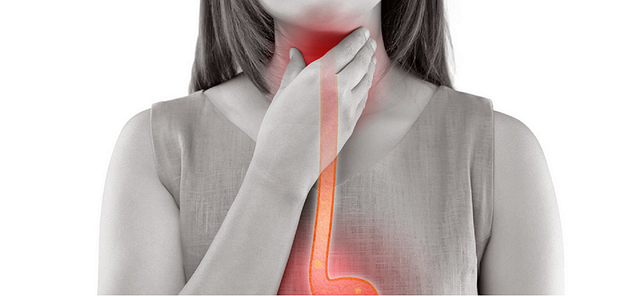Gastroesophageal reflux in children from toddler period to adulthood
Diagnosis and non-pharmacological treatment
Gastroesophageal reflux (GER) characterizes the reverse flow of gastric contents into the esophagus. To some extent, this is a physiological process that can occur throughout the day in both children and adults. If ger-related problems occur, we define it as gastroesophageal reflux disease (GERD).Risk factors in childhood include: chronic respiratory diseases (bronchial asthma, primary ciliary dyskinesia, cystic fibrosis, etc.), constipation, obesity and psychomotor delay. However, it often occurs without these factors. GER is formed by transient relaxation of the lower esophageal sphincter (DJS).
The esophagus runs from the oral cavity to the stomach through an opening (hiatus) in the diaphragm. The diaphragm is the main respiratory muscle and determines the optimal tension in the thoracic and abdominal cavity. DJS is located under the diaphragm, in the lower region of the esophagus (called cardia, or gastroesophageal junction). DJS can be thought of as a muscle ring that differs from other muscles of the esophagus and stomach by a higher tension and also by a different response to hormonal, pharmacological and nerve stimuli. The separation of the esophagus and stomach is achieved precisely by the higher tension of the DSJ. The main causes of GERD include a decrease in DJS tension, antral hypomotility (reduced mobility of the stomach in the area of DJS, possibly even duodenogastric reflux – reflux of bile from the small intestine to the stomach).
Difficulties caused by GER arise from exposure of esophageal tissue to gastric acidic contents. GERD can manifest itself: pylorosis, pain behind the sternum, a feeling of acidity in the mouth, repeated vomiting, increased tooth decay, morning sore throat. These specific problems may be associated with non-specific difficulties such as: restlessness, intermittent sleep, refusal to eat, more serious symptoms include aspiration pneumonia, chronic bronchitis, irritating cough, apnea, repeated inflammation of the larynx, middle ears and sinuses.
In addition to these somatic difficulties, we find specific associated blocks in muscles and ligamentous formations and their concatenation indicating this dysfunction. Sometimes the typical standing of a child with GERD is noticeable, with the center of gravity in front, up to a slight forward bend, with the right shoulder slightly oriented forward and the left shoulder turned backwards and slightly drooping .A slight rotation of the torso to the left is probably the result of turning the lower part of the esophagus downwards and obliquely to the left. During neural examination, we find the involvement of n. vagus and n. phrenicus on the left, which we palpate as higher tension in precisely defined areas.
In hiatal hernia (part of the stomach de facto passes through the hole in the diaphragm), which is also one of the causes of GERD, we find tension on the fascia of the neck and torso on the left. Due to the above disorders associated with GERD, the child may complain of pain in the left side of the neck and left-sided headache, left-sided pain in the upper limb. The fourth intercostal is often sensitive. In adults, up to left-sided frozen shoulder syndrome may occur. I have repeatedly encountered this comorbidity in a long-lasting GERD in an adult patient, and it is not so common in a child and an adolescent. However, what is a frequent phenomenon in children is the limited mobility of the jaw joint connecting and the pain of the head part behind the left ear, in the area of the cranial seam of the so-called occipitomastoideal suture.
There are many different investigative procedures. In children, a carefully conducted medical history is probably the most important, and the gold standard is the 24-hour measurement of pH in the esophagus (esophageal pHmetry). Which is represented by the introduction of a thin probe through the nose into the esophagus; connection of the probe recording the pH in the esophagus. The patient performs normal activities within 24 hours, eats normal food, and then the probe is taken out and the record is evaluated (note: there are also other special examination methods, but they are not the topic of this text).
If GERD is suspected, treatment should be initiated in the first place. In the hands of the doctor is the question of the use of medication, but its results in children may be questionable (the desired effect is not always achieved even in adults). In most professional articles, you will read that in children from toddler to adolescent age, it is not proven that success in treatment is brought by some of the regimen measures that are usually recommended for infants. Thus, similar recommendations can be applied in adolescents as in adults.Therefore, the advice remains very general: first of all, it is recommended to reduce weight in obese people, do not smoke and drink alcohol, do not eat shortly before falling asleep, or adjust the position in sleep (e.g. sleep on the left side).
As the main therapeutic method, I would recommend manual treatment such as visceral and neural techniques, exercises focused on the proper functioning of the diaphragm and trunk muscles and specific regime measures. It is necessary to work with the diaphragm, tissues and organs around the cardia, or in the neck and head area. Neural treatment of nerves that are negatively affected by GERD and that innervate DJS can also help. We can never forget the treatment of the fascia of the chest and neck. All these methods are not demanding for an adult or a child, neither in terms of time nor otherwise. Only if it is necessary to work with the diaphragm and other muscles of the trunk, it is necessary to find time for daily exercises in the home environment. Working with the diaphragm means changing the tension of the muscle and ligamentous part, as well as the surrounding muscles, optimizing their mutual coordination and their activity. If a parent exercises with a child at home, a better effect is always achieved. It is up to each physiotherapist what method of harmonizing the tone of the diaphragm he chooses and how he is able to pass the exercise to parents and the child patient.
In addition to the general advice, I would also like to specify the regime’s measures. Children should not eat immediately before bedtime, they should not wear a tight belt or other tight clothing, I recommend sleeping with the upper torso and head on the pillow, not staying long in a forward bend or during sports or other activity, do not stay with raised arms or bowed head, prevent constipation with an appropriate diet and avoid eating oranges and other citrus, chocolate, tea, fatty foods, fried foods, mustard, if you already consume these foods so never in the evening, but as a first course and in small quantities. For girls who are already menstruating, it is advisable to avoid food just before menstruation, because hormonal changes in the body also affect the tone of DJS. For adolescents or anyone else who suffers from GERD and not only because of GERD, I do not recommend coffee, tobacco or alcohol.
Mgr. Michaela Zahrádka Kohlerová
Reference
1. BARRAL, Jean-Pierre, MERCIER, Pierre. Viscerální terapie, Poznání, ISBN 80-239-6721-5.
2. http://eportal.chirurgie.upol.cz/portal_final/?page_id=241
3. http://www.nemcb.cz/cz/page/76/Vysetreni-hodinovou-phmetrii.html?detail=409
4. KLUSÁČEK, Dalibor. GASTROEZOFAGEÁLNÍ REFLUX V DĚTSKÉM VĚKU. Pediatrie pro praxi [online]. 2001, roč. 2, vol. 1, s. 36-38, dostupné také z <http://www.solen.cz/pdfs/ped/2001/01/11.pdf>. ISSN 1803-5264.
5. MUNTAU, Ania Carolina. Pediatrie. 4. vydání. Praha: Grada, 2009. s. 359. ISBN 978-80-247-2525-3.
6. THOMSON, Mike Andrew. Endoscopic approaches to the treatment of GERD. J Pediatr Gastroenterol Nutr [online]. 2011, vol. 53 Suppl 2, s. S11-3, dostupné také z <https://www.ncbi.nlm.nih.gov/pubmed/22235451>. ISSN 0277-2116 (print), 1536-4801.
7. VAN DER POL, Rachel, Marije SMITE a Marc A BENNINGA, et al. Non-pharmacological therapies for GERD in infants and children. J Pediatr Gastroenterol Nutr [online]. 2011, vol. 53 Suppl 2, s. S6-8, dostupné také z <https://www.ncbi.nlm.nih.gov/pubmed/22235448>. ISSN 0277-2116 (print), 1536-4801.
8. VANDENPLAS, Yvan, Colin D RUDOLPH a Carlo DI LORENZO, et al. Pediatric gastroesophageal reflux clinical practice guidelines: joint recommendations of the North American Society for Pediatric Gastroenterology, Hepatology, and Nutrition (NASPGHAN) and the European Society for Pediatric Gastroenterology, Hepatology, and Nutrition (ESPGHAN). J Pediatr Gastroenterol Nutr [online]. 2009, vol. 49, no. 4, s. 498-547, dostupné také z <https://www.ncbi.nlm.nih.gov/pubmed/19745761>. ISSN 0277-2116 (print), 1536-4801.
9. WENZL, Tobias G, Marc A BENNINGA a Clara M LOOTS, et al. Indications, methodology, and interpretation of combined esophageal impedance-pH monitoring in children: ESPGHAN EURO-PIG standard protocol. J Pediatr Gastroenterol Nutr [online]. 2012, vol. 55, no. 2, s. 230-4, dostupné také z <https://www.ncbi.nlm.nih.gov/pubmed/22711055>. ISSN 0277-2116 (print), 1536-4801.

